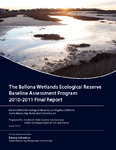- DSpace Home
- →
- Channel Islands
- →
- Academic Affairs
- →
- Faculty Scholarly and Creative Activities
- →
- Anderson, Sean
JavaScript is disabled for your browser. Some features of this site may not work without it.
| dc.contributor.author | Anderson, Sean | en |
| dc.contributor.author | Johnston, Karina | en |
| dc.contributor.author | Del Giudice-Tuttle, Elena | en |
| dc.contributor.author | Medel, Ivan | en |
| dc.contributor.author | Piechowski, Charles | en |
| dc.contributor.author | Cooper, Dan | en |
| dc.contributor.author | Dorsey, John | en |
| dc.date.accessioned | 2015-06-22T19:10:32Z | en |
| dc.date.available | 2015-06-22T19:10:32Z | en |
| dc.date.issued | 2012-06 | en |
| dc.identifier.uri | http://hdl.handle.net/10211.3/141418 | en |
| dc.description.abstract | The mission of the Santa Monica Bay Restoration Commission (SMBRC) is to restore and enhance the Santa Monica Bay (Bay) through actions and partnerships that improve water quality, conserve and rehabilitate natural resources, and protect the Bay’s benefits and values. The SMBRC is charged with implementing the Bay Restoration Plan, a stakeholder-developed plan that describes goals, objectives, and milestones to address the environmental problems facing the Bay and the Bay’s watersheds. Scientific monitoring of the Bay’s natural resources and restoring coastal wetlands are important parts of the Bay Restoration Plan. In September 2011, the SMBRC completed the second year of baseline assessment surveys at the Ballona Wetlands Ecological Reserve (BWER). The comprehensive surveys were developed in partnership with the California Department of Fish and Game and the California State Coastal Conservancy to assess the condition of the BWER and inform the state’s wetlands restoration planning. The surveys incorporated monitoring and assessment of biological, chemical, and physical components of the BWER ecosystem. Vegetation, seed core, terrestrial invertebrate, and elevation surveys were conducted on permanent transects randomly located throughout all habitat types at the BWER. Additional biological data collected included surveys for small and large mammals, vertebrate mortality along roads, herpetofauna, ichthyofauna, benthic invertebrates, birds, and submerged aquatic vegetation (Table 1). Water quality data collected included dissolved metals, fecal indicator bacteria, nutrients, and additional parameters. Sediment quality data included trace metals, amphipod toxicity, grain size, and total organic carbon. This document provides a summary of the data collected during the second year of the Baseline Assessment Program (BAP) survey of the BWER. | en |
| dc.language.iso | en_US | en |
| dc.subject | Ballona Wetlands Ecological Reserve | en |
| dc.subject | California State Coastal Conservancy | en |
| dc.subject | California Department of Fish and Game | en |
| dc.subject | Santa Monica Bay Restoration Commission | en |
| dc.title | The Ballona Wetlands Ecological Reserve Baseline Assessment Program 2010-2011 Final Report | en |
| dc.type | Report | en |
Files in this item
This item appears in the following Collection(s)
-
Anderson, Sean [2]

